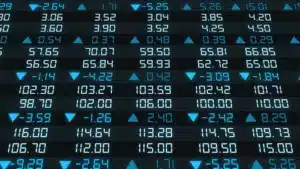Commonwealth Bank of Australia
(ASX: CBA)Share Price and News

Overview of Commonwealth Bank of Australia (ASX:CBA)
Commonwealth Bank of Australia is the biggest of Australia's Big 4 Banks and is the largest company on the ASX, capped at over $290bn. It is a diversified financial services provider, offering banking, wealth management, insurance, and investment services; but its bread and butter is lending (to personal and business customers).
It serves millions of customers through a strong digital presence and an extensive network of branches and ATMs. It has hundreds of thousands of retail shareholders, and millions more with super funds that own shares. With a diverse revenue base and a resilient business model, CBA remains a cornerstone of Australia’s financial system.
CBA Company History
The Commonwealth Bank of Australia was established by the Australian government in 1911, initially offering savings and general banking services. It also served as a central Bank and gained a reputation through its actions during the World War (providing banking services to troops serving abroad) and its school banking program (which began in 1931).
In 1957, its trading/savings and central bank operations were separated but the bank remained one company. Then in 1960, today's RBA was founded from the latter division. Since then it has been a significant innovator including introducing Bankcard (the first credit card in Australia) in 1974 and launching ATMs in 1981, then EFTPOS in 1984.
During the 1990s it was privitised over 6 years in a process that led to it being listed in 1991. During the 2000s it made significant inroads overseas, particularly in Asia. During that decade, it bought wealth management group Colonial and BankWest.
During the pandemic, the company's share price took a hit, but its share in the mortgage market put it in good stead to take advantage of the lending boom that occured during the pandemic. And this is paying off; in each of the last 2 financial years, it made >$10bn profits.
Future Outlook of Commonwealth Bank of Australia (ASX: CBA)
The future outlook for Commonwealth Bank is shaped by its recent financial performance and prevailing sector trends.
At first glance, it is hard to see anything but positivity. CBA has made back to back $10bn profits, driven by growth in home lending and improved fee income from wealth management. It paid out over $4.50 per share as dividends, amounting to over $8bn.
Moreover, the bank doesn't only have the most customers and a big loan book, but it has certain advantages over its peers such as its tech stack and lower reliance on mortgage brokers for leads. As a recent note from Macquarie pointed out, no other retail bank has grown its revenues in 5 years.
There is a lot of debate about whether or not shares are overvalued, but at the end of the day, what is going to be the catalyst that causes them to crash? Clearly only a major financial crisis like the GFC of COVID. And as Warren Buffet said,’ Price is what you pay value is what you get’. It is easy to look at the bank’s market capitalisation and share price, but it is important to look at all the other factors pointing to the fact that the bank is better off than its peers.
This said, there are some risks including a potential lack of profit growth, that the bank is trading at higher multiples than its peers and the risk the decline in interest rates could lead to falling margins.
Is CBA a Good Stock to Buy?
Overall, CBA’s disciplined risk management, ongoing innovation, and diversified operations position it well to navigate an increasingly competitive and regulated banking environment. Dividend investors will struggle to go wrong given it pays so much in dividends, even if it isn't necessarily the highest yielding.
There are macroeconomic risks such as interest rate volatility and potential corrections in the housing market. Nonetheless, CBA’s strong capital position and broad revenue base help to mitigate these concerns.
Our Stock Analysis
If negative gearing is wound back, could it hurt ASX bank stocks?
Negative gearing is a contentious topic and Australians are heavily divided on it. What is negative gearing? Why is…
Here’s what you need to know about AML and CTF laws if you invest in The Big 4 Banks
AML and CTF laws are particularly relevant to a handful of large companies, particularly the Big Four Banks as well…
CET1 ratio: If you invest in ASX bank stocks, here’s why it is an important metric to know
In this article we look at the Common Equity Tier 1 (CET1) ratio – what it is and why it…
6 ASX Stocks to watch with an eager eye this FY24 reporting season
6 ASX Stocks to watch this FY24 reporting season Nick Scali (ASX:NCK) Nick Scali has doubled in the last…
Here are 5 ASX Stocks for young investors to buy
5 ASX Stocks for young investors to buy If you’re a young investor, you are less likely to be a…
Custodian trades: Here’s why it wasn’t really JP Morgan, HSBC or CBA that risked their money on your stock
Custodian trades are trades that make it appear like a major bank has bought or sold your company, but it…
- « Previous
- 1
- 2
- 3
- 4
- Next »
Frequently Asked Questions
CBA’s dividend yield typically ranges between 4% and 5%, reflecting its ongoing commitment to returning capital to shareholders. Dividends are supported by stable earnings and a strong payout ratio, making the bank appealing to income investors.





